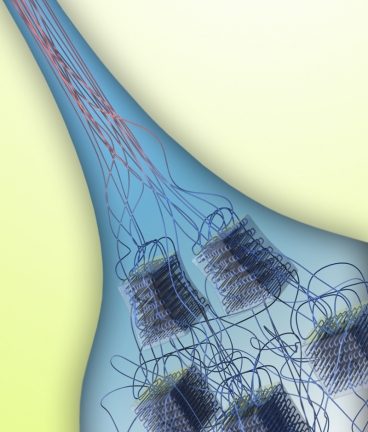Most polymers - materials consisting of long chain-like particles - are very good heat and electrical insulators. However, a research team from MIT found a way to turn the most useful polymer today, polyethylene, into a material that conducts heat at the level of most metals, while remaining an electrical insulator.

The new process causes the polymer to conduct heat very efficiently along one axis only, unlike metals, which conduct heat in all directions to the same extent. This finding could make the material especially useful for applications where it is important to keep heat away from a certain object, such as computer chips. The research findings were published in the scientific journal Nature Materials.
The key factor in this successful conversion was the ability to organize all the polymer particles to line up in the same direction, as opposed to their usual chaotic state. The research team was able to do this by slowly pulling a polyethylene fiber from a solution, through fine control of the cantilever of an atomic force microscope (AFM) which was also used to measure the properties of the finished fiber.
This fiber conducted electricity three hundred times better than regular polyethylene along the axis of the individual fibers, notes lead researcher Gang Chen, a professor of electrical engineering at the MIT Research Institute.
The high thermal conductivity could make these fibers useful for heat dissipation in many applications where metals are used today, such as solar collectors for heating water, heat converters and various electronic components.
The lead researcher explains that most of the previous attempts to prepare polymers with improved thermal conductivity focused on combining them with other materials, such as carbon nanotubes, but in these combined materials only a moderate increase in conductivity was observed because the interface between the two types of materials tended to add heat resistance. "The interfaces actually dissipate heat, so no significant improvement is obtained," the researcher points out. However, by using this new method, the conductivity was increased to such a great extent that it was better than half of the pure metals, including iron and platinum.
The creation of the new fibers, in which the polymer strands are all arranged in the same direction instead of being out of order, required a two-step process, explains one of the researchers. First the polymer is heated and drawn out, then heated again to stretch it further. "Once it solidifies at room temperature, it can no longer be deformed to a large extent," explains the lead researcher.
Even greater benefits may emerge as the method improves, says the lead researcher, noting that even the findings obtained so far represent the highest thermal conductivity yet achieved in polymeric materials. Already now, the level of conductivity obtained, if it is possible to produce these fibers on an industrial scale, could provide a cheaper alternative to metals used to dissipate heat in a variety of applications, especially in those where the directional characteristics will be significant, such as heat exchangers (such as the cylindrical tubes in the back of a freezer or in the air conditioner), cases for mobile phones, or plastic packaging for computer chips. It will be possible to plan other applications that will take advantage of the advantages of the innovative material such as a unique combination of heat conductivity with low weight, chemical stability and electrical insulation. So far, the team has succeeded in producing individual fibers in a laboratory setting, says the researcher, but "we hope that in the future we will be able to transfer the production to an industrial scale," while producing entire surfaces of the innovative material with the same characteristics.
Ravi Prasher, an engineer at the chip company Intel, says that "the findings of this research are extremely significant" and will be able to help in the development of many applications in electronics. The question that remains is to what extent it will be possible to transfer the production process to a commercial scale, and how it will be possible to integrate these fibers in practical applications.

One response
Very interesting! It's nice to see that with every passing day we find more expressions of nanotechnologies and carbon-based materials. In this article it is said that the material created in its ordered form conducts 3 orders of magnitude more than the same material in its disordered form and that this conduction is better than iron and platinum. It is surprising to learn that only three orders of magnitude separate the conductivity of a metal from the conductivity of a carbohydrate. You would think that it is much more, but apparently the gap is not in the sky and they have indeed shown that it can be bridged with the help of manipulating the material. exciting